Migration from PostgreSQL database to MS SQL Server
M365 Manager Plus comes bundled with a PostgreSQL database to store the product's data from its reporting, monitoring, management, and auditing modules. The solution also supports MS SQL Server and enables you to migrate product data from the built-in PostgreSQL to an MS SQL database. This guide will walk you through the database migration process.
Supported versions of MS SQL Server: 2008 R2, 2012, 2014, 2016, 2017, 2019, and 2022.
Prerequisites for the migration process
Make sure that the following conditions are satisfied in the MS SQL Server to which you want to migrate the data:
- The SQL Server browser must be up and running.
- For SQL Server network configuration, TCP/IP protocol must be enabled.
- All the client protocols must be enabled.
- MS SQL Server access is delegated to a user with sysadmin and db_owner permissions at the server and database levels respectively.
Refer to Appendix A for configuring prerequisites 1, 2, and 3. Refer to Appendix B for configuring prerequisite 4.
Migrating from PostgreSQL to MS SQL
Migrating data from M365 Manager Plus’ default PostgreSQL database to MS SQL consists of the following two steps:
- Backing up the M365 Manager Plus database
- Migrating PostgreSQL data to MS SQL
Step 1: Backing up the M365 Manager Plus database
If you're migrating the database of a fresh installation, then you can skip this step.
- Stop M365 Manager Plus. (it's essential to stop M365 Manager Plus before performing the backup).
- If M365 Manager Plus is running in console mode, click the Windows icon. Search for M365 Manager Plus, and choose Stop M365 Manager Plus.
- If M365 Manager Plus is running as a service, click the Windows icon. Search for Services. In the window that appears, choose ManageEngine M365 Manager Plus, and select the Stop the service option on the left side.
- Navigate to <M365 Manager Plus installation directory>\bin.
Note: By default, M365 Manager Plus is installed in: C:\Program Files\ManageEngine\M365 Manager Plus
- Run the backupDB (Windows batch) file as an administrator. Do not terminate until the process is finished.

- Data in the default database of M365 Manager Plus will be backed up and stored under <M365 Manager Plus installation directory>\backup\O365_Backup _<Backup Time>
Note: If the below error shows up while running the backupDB file, make sure that the product has been stopped before proceeding.

Step 2: Migrating PostgreSQL Data to MS SQL
Note: Make sure that M365 Manager Plus is stopped before the migration process.
- If MS SQL Server is installed in a remote computer, install the necessary command line utilities and native Client, and then proceed to the next step.
Note: Download the corresponding command line utilities and native clients from the links below. On clicking the Download button in the page displayed, you will see a listing of SQL Native Client or command line utilities. The command line utilities have the term SQLCMD in them, and the native client file can be found under the name sqlncli. Install the corresponding SQL Native Client or command line utilities as per the MS SQL Server version and CPU type of the machine in which M365 Manager Plus is installed.
- Copy the following files to the <M365 Manager Plus installation directory>\bin folder.
- bcp.exe - <MSSQL installation directory>\Tools\Bin\bcp.exe
- bcp.rll - <MSSQL installation directory>\Tools\Bin\Resources\1033\bcp.rll
- If your firewall is enabled in the Microsoft SQL Server machine, the TCP and UDP ports must be opened.
- If you are migrating to a Microsoft SQL server that has Force encryption enabled, follow the steps mentioned below.
- Convert your certificate to CER format.
- Open IIS Manager.
- In the middle pane, click Server Certificates.
- Open the certificate you want to use, and click the Details tab.
- Click Copy to file.
- Click Next in the Certificate Export Wizard that appears.
- On the Export Private Key screen, select No, do not export the private key, and click Next.
- On the Export File Format screen, select either DER encoded binary X.509 (.CER) or Base-64 encoded X.509 (.CER), and click Next.
- Enter a name for the file, click Next, and then Finish.
or
- Export SSL certificate from SQL Configuration Manager
- Open Microsoft Management Console.
- Navigate to SQL Server Configuration Manager > SQL Server Network Configuration.
- Select the protocols for the server that you wish to export the SSL certificate from.
- Right click on the selected option and click Properties.
- Click on the Certificate tab, select the certificate that you wish to export, and click View.
- Click Copy to File in the new window that opens and save the certificate in a folder of your choice.
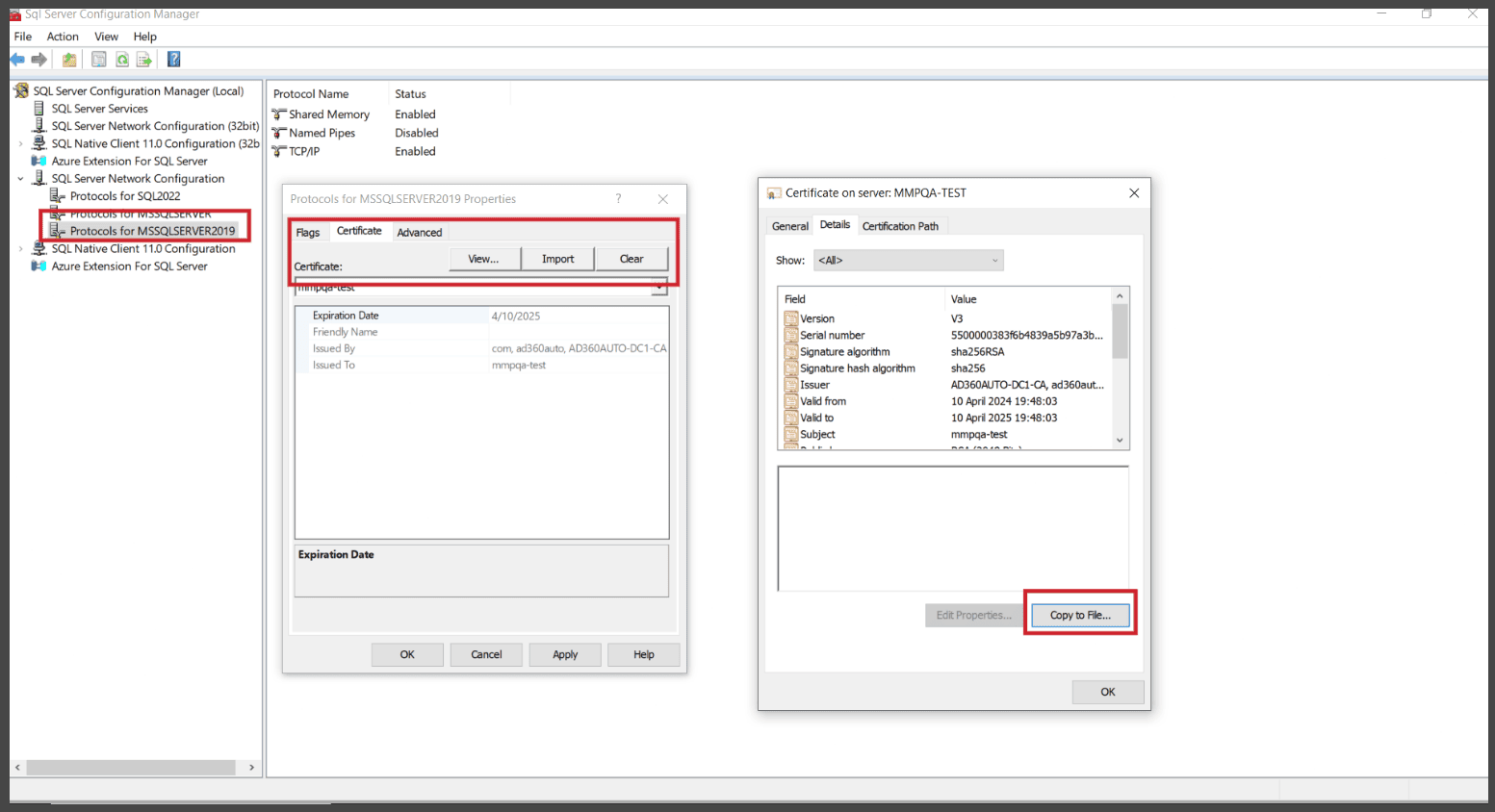
- Open the Command Prompt and navigate to <Installation directory>\jre\bin. Use the command below to associate the certificate with the Java KeyStore.
keytool -import -v -trustcacerts -alias myserver -file pathofthecert\certname.cer -keystore "..\lib\security\cacerts" -keypass changeit -storepass changeit -noprompt
where pathofthecert is the location where the certificate has been stored and certname is the certificate name.
- The certificate will be added to your Java KeyStore.
- Navigate to <M365 Manager Plus directory>\bin.
- Run the ChangeDB batch file as an administrator. In the Database Setup Wizard that appears, select MS SQL Server as the Server Type.
- Enter the Host Name and Port number of MS SQL Server.
- Select the SQL Server Instance from the drop-down.
- Select the Authentication type.
- If you choose Windows Authentication, provide the Domain Name, User Name, and Password of the user account that has access to the server.
- If you choose SQL Server Authentication, provide the User Name and Password of the user who has access to the MS SQL Server instance.
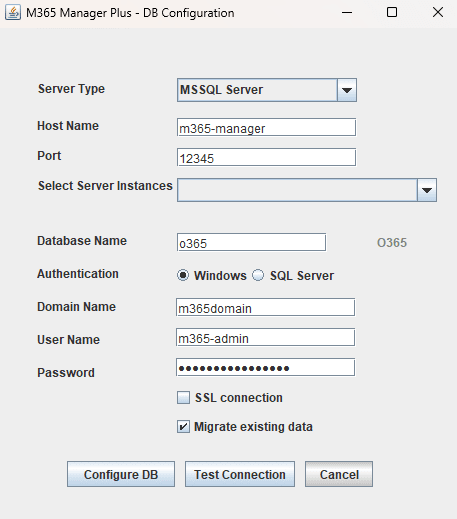
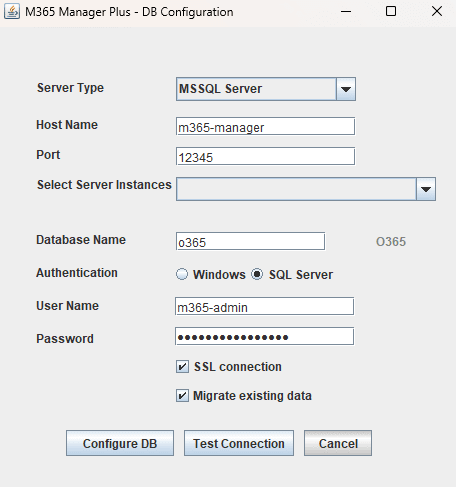
- If the Microsoft SQL server you wish to migrate to has Force encryption on, check the SSL connection box.
- If you want to migrate all the data stored in the default database and also keep a copy of it in the newly-migrated database, check the box next to Migrate existing data. If you do not want to migrate the data, you can leave it unchecked.
Note By choosing either option, data will remain in the default PostgreSQL database even after the migration. However, the MS SQL database will be active and used to store all the product data.
- Click on Test Connection. If the test fails, then recheck your credentials and try again.
- Click Configure DB to finish the MS SQL Server configuration.
- Start the M365 Manager Plus Server/Service to work with MS SQL Server as the database.
Appendix A
Configuring MS SQL Server
If you already have a functional MS SQL Server, then this step is not required. Follow the steps below to configure a new MS SQL Server installation.
- Run compmgmt.msc in Command Prompt to open the SQL Server Configuration Manager.
- Go to SQL Server Services, and ensure that SQL Server Browser is running.
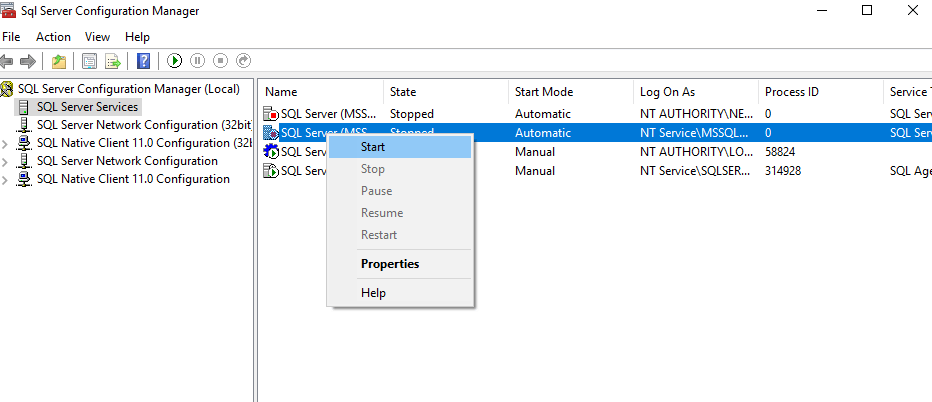
- . In the left pane, click SQL Server Network Configuration, double-click Protocols for SQLEXPRESS.
Note SQLEXPRESS is the instance name provided while configuring MS SQL Server. This name will be used for reference
- In the pop-up that appears, go to the Protocol tab, and enable TCP/IP. Restart the SQL Server SQLEXPRESS Service.
- Go back to SQL Server Configuration Manager. In the left pane:
- Navigate to SQL Server Network Configuration > Protocols for SQLEXPRESS, and enable all the protocols.
- Navigate to SQL Native Client Configuration > Client Protocols, and enable all the protocols.
Appendix B
Delegating MS SQL Server access to users
To complete the migration process, you need a database admin account for the MS SQL connection. If M365 Manager Plus is already running as a Windows service, you can use its service account as the MS SQL database admin account. Check if the account has the required privileges. If there is no previously configured service account in MS SQL Server, follow the steps given below to create a new user account, and assign required permissions to it.
- Log in to SQL Server Management Studio.
- In the left pane, navigate to Machine Name > SQLEXPRESS > Security > Logins.
- Right-click on Logins, and select New Login.
- Provide a Login Name, and choose whether to use Windows Authentication or SQL Server Authentication.
- If you choose Windows Authentication, enter the Windows NT name of the user to whom access must be granted.
- If you choose SQL Server Authentication, you will be prompted to create a new Username and Password.
- The new user must have the sysadmin role in the server level and db_owner role in the database level. Follow these steps to provide the sysadmin and db_owner role permissions to the new user:
- Navigate to Machine Name > SQLEXPRESS > Security > Logins. Right-click the user > Properties.
- Go to Server Roles, select the sysadmin box, and click OK.
- Go to User Mapping in the left pane. In the Users mapped to this login list, check the database and in the Database role membership for list, select db_owner, and click OK.
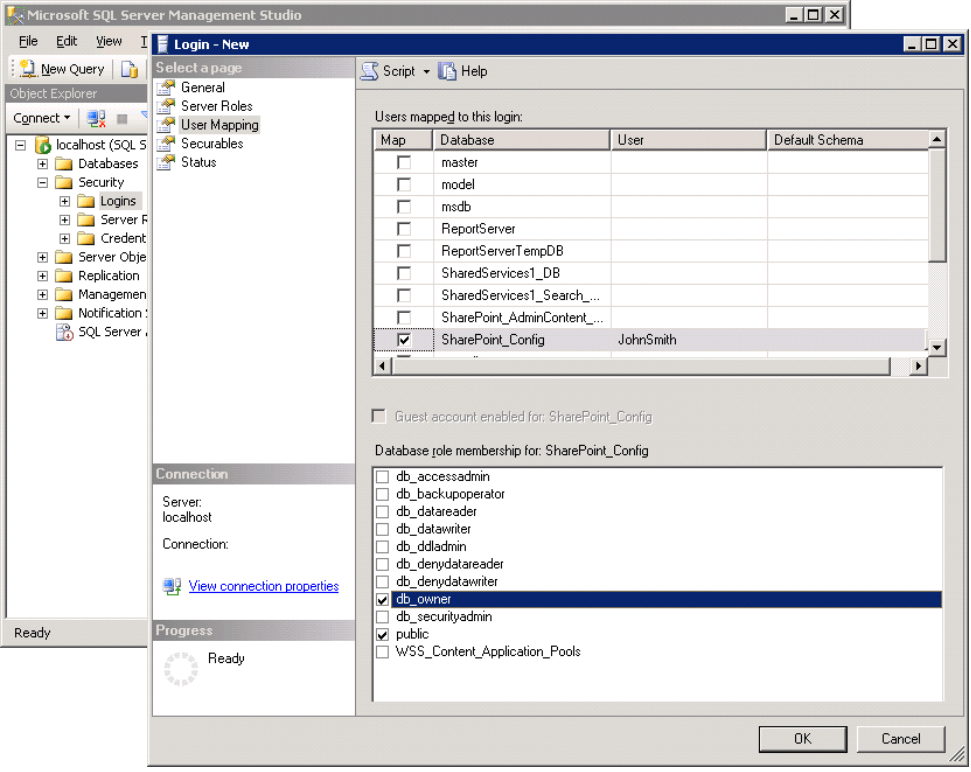
Note For details about user roles, refer to the following documents:
In general, the configured account needs one of these three sets of privileges to complete the migration process successfully:
| |
Required database role |
Required permissions |
| Set 1 |
db_owner |
Not required |
| Set 2 |
db_datareader,
db_datawriter,
db_ddladmin,
db_backupoperator. |
Not required |
| Set 3 |
db_ddladmin |
ALTER ANY TABLE,
ALTER ANY AGGREGATE,
ALTER ANY DEFAULT,
ALTER ANY FUNCTION,
ALTER ANY PROCEDURE,
ALTER ANY QUEUE, ALTER ANY RULE,
ALTER ANY SYNONYM,
ALTER ANY TYPE,
ALTER ANY VIEW,
ALTER ANY XML SCHEMA COLLECTION,
ALTER ANY REFERENCES,
CONTROL ON CERTIFICATE::[ZOHO_CERT]
TO [user],
CONTROL ON SYMMETRIC
KEY::[##MS_DatabaseMasterKey##] TO [user],
CONTROL ON SYMMETRIC KEY::[ZOHO_SYMM_KEY]
TO [user]
|
Important:
Please note that you must have the db_owner permission while migrating PostgreSQL to MS SQL for the first time. After a successful migration, you can revoke the db_owner permission for the account, and provide the set 2 or set 3 permissions.






